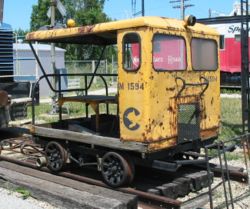
A speeder (also known as a section car, railway motor car, putt-putt, track-maintenance car, crew car, jigger, trike, quad, personnel carrier, trolley, inspection car, or draisine) is a small railcar used around the world by track inspectors and work crews to move quickly to and from work sites. [1] Although slow compared to a train or car, it is called speeder because it is faster than a human-powered vehicle such as a handcar. Motorized inspection cars date back to at least 1895, when the Kalamazoo Manufacturing Company started building gasoline-engined inspection cars. [2]
Contents
- Motorcar manufacturers and models
- Dimensions
- In popular culture
- Gallery
- See also
- Notes
- References
- External links
In the 1990s, many speeders were replaced by pickup trucks or sport utility vehicles with additional flanged wheels that could be lowered for travelling on rails, called "road–rail vehicles" or hi-rails for "highway-railroad". Speeders are collected by hobbyists, who refurbish them for excursions organized by the North American Railcar Operators Association [3] in the U.S. and Canada and the Australian Society of Section Car Operators, Inc. in Australia.







